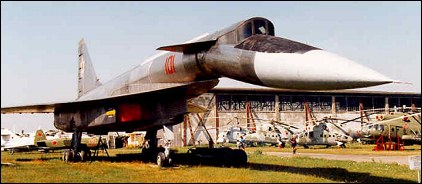 |
Sukhoi T-4 (100)1972 |  |
| BOMBER | Virtual Aircraft Museum / USSR / Russia / Sukhoi |
 |
This enormous project was triggered in December 1962 by the need to intercept the B-70 (or RS-70), 'A-11' (A-12, later SR-71), Hound Dog and Blue Steel. At an early stage the mission was changed to strategic reconnaissance and strike for use against major surface targets. It was also suggested that the basic air vehicle could form the starting point for the design of an advanced SST. From the outset there were bitter arguments. Initially these centred on whether the requirement should be met by a Mach-2 aluminium aircraft or whether the design speed should be Mach 3, requiring steel and/or titanium. In January 1963 Mach 3 was selected, together with a design range at high altitude on internal fuel of 6,000km. General Constructors Sukhoi, Tupolev and Yakovlev competed, with the T-4, Tu-135 and Yak-33 respectively. The Yak was too small (in the TSR.2 class) and did not meet the requirements, and though it looked like the B-70 the Tupolev was an aluminium aircraft designed for Mach 2.35. From the start Sukhoi had gone for Mach 3, and its uncompromising design resulted in its being chosen in April 1963. This was despite the implacable opposition not only of Tupolev but also of Sukhoi's own deputy Yevgenii Ivanov and many of the OKB's department heads, who all thought this demanding project an unwarranted departure from tactical fighters. Over the next 18 months their opposition thwarted a plan for the former Lavochkin OKB and factory to assist the T-4, and in its place the Boorevestnik OKB and the TMZ factory were appointed as Sukhoi branch offices, the Tushino plant handling all prototype construction. A special VVS commission studied the project from 23rd May to 3rd June 1963, and a further commission studied the refined design in February-May 1964. By this time the T-4 was the biggest tunnel-test project at CAHI (TsAGI) and by far the largest at the Central Institute of Aviation Motors. The design was studied by GKAT (State aircraft technical committee) from June 1964, and approved by it in October of that year. By this time it had outgrown its four Tumanskii R-15BF-300 or Zubets RD-17-15 engines and was based on four Kolesov RD-36-41 engines. In January 1965 it was decided to instal these all close together as in the B-70, instead of in two pairs. Mockup review took place from 17th January to 2nd February 1966, with various detachable weapons and avionics pods being offered. Preliminary design was completed in June 1966, and because its take-off weight was expected to be 100 tonnes the Factory designation 100 was chosen, with nickname Sotka (one hundred). The first flight article was designated 101, and the static-test specimen 100S. The planned programme then included the 102 (with a modified structure with more composites and no brittle alloys) for testing the nav/attack system, the 103 and 104 for live bomb and missile tests and determination of the range, the 105 for avionics integration and the 106 for clearance of the whole strike/reconnaissance system. On 30th December 1971 the first article, Black 101, was transferred from Tushino to the LII Zhukovskii test airfield. On 20th April 1972 it was accepted by the flight-test crew, Vladimir Ilyushin and navigator Nikolai Alfyorov, and made its first flight on 22nd August 1972. The gear was left extended on Flights 1 through 5, after which speed was gradually built up to Mach 1.28 on Flight 9 on 8th August 1973. There were no serious problems, though the aft fuselage tank needed a steel heat shield and there were minor difficulties with the hydraulics. The VVS request for 1970-75 included 250 T-4 bombers, for which tooling was being put in place at the world's largest aircraft factory, at Kazan. After much further argument, during which Minister P V Dement'yev told Marshal Grechko he could have his enormous MiG-23 order only if the T-4 was abandoned, the programme was cancelled. Black 101 flew once more, on 22nd January 1974, to log a total of 10hrs 20min. Most of the second aircraft, article 102, which had been about to fly, went to the Moscow Aviation Institute, and Nos 103-106 were scrapped. Back in 1967 the Sukhoi OKB had begun working on a totally redesigned and significantly more advanced successor, the T-4MS, or 200. Termination of the T-4 resulted in this even more remarkable project also being abandoned. In 1982 Aircraft 101 went to the Monino museum. The Kazan plant instead produced the Tu-22M and Tu-160. Yefim Gordon and Bill Gunston "Soviet X-Planes", 2000

|  COMPANY PROFILE | |||||||||||||||||||||||||||||||||||||||||||||||||||||||||
 |

|

